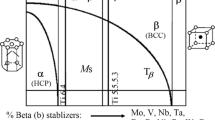Abstract
Cutting tool suffers rapidly during machining titanium-based alloys due to low thermal conductivity. Thus most of the heat is concentrated on the tool rather than chip during machining. To overcome this problem, a suitable cutting parameter, tool geometry, and sustainable methods are necessary. This paper presents the effect of MoS2 solid lubricant (SL), cutting speed, and nose radius during turning of Ti-6Al-4V alloy using the TiAlN coated carbide tool. The experiments are performed at different cutting speeds, nose radius, and flow rates of solid lubricant to study tool wear, surface roughness, and chip morphology. The results show that the use of solid lubricant reduces the tool wear (37%), and the surface roughness (65%) compared to the dry cutting. Similarly, the effects of nose radius and cutting speed have also been studied for both conditions.













Similar content being viewed by others
References
Kumar M, Datta S and Kumar R, 2019 Electro-discharge Machining Performance of Ti-6Al-4V Alloy: Studies on Parametric Effect and Phenomenon of Electrode Wear, Arab. J. Sci. Eng. 44: 1553–1568. https://doi.org/10.1007/s13369-018-3632-1
Sharma A, Dutt M and Rakesh S, 2013 Experimental Study of Machining Characteristics of Titanium Alloy (Ti-6Al-4V), 3201–3209. https://doi.org/10.1007/s13369-012-0451-7
Balamurugan K, Uthayakumar M, Kumaran S T Samy G S and Pillai U T S 2019 Drilling study on lightweight structural Mg/SiC composite for defence applications, Def. Technol. https://doi.org/10.1016/j.dt.2019.01.002
Parida A K and Maity K, 2018 Analysis of some critical aspects in hot machining of ti-5553 superalloy: Experimental and FE analysis, Def. Technol. https://doi.org/10.1016/j.dt.2018.10.005
Parida A K 2018 Simulation and experimental investigation of drilling of Ti-6Al-4V alloy, Int. J. Light. Mater. Manuf. https://doi.org/10.1016/j.ijlmm.2018.07.001
Amiril S A S, Rahim E A and Syahrullail S, 2017 A review on ionic liquids as sustainable lubricants in manufacturing and engineering: Recent research, performance, and applications, J. Clean. Prod. 168: 1571–1589. https://doi.org/10.1016/j.jclepro.2017.03.197
Mia M and Dhar N R 2018Effects of duplex jets high-pressure coolant on machining temperature and machinability of Ti-6Al-4V superalloy, J. Mater. Process. Technol. 252: 688–696 https://doi.org/10.1016/j.jmatprotec.2017.10.040
Su Y, He N, Li L and Li X L 2006 An experimental investigation of effects of cooling/lubrication conditions on tool wear in high-speed end milling of Ti-6Al-4V, Wear 261: 760–766 https://doi.org/10.1016/j.wear.2006.01.013
Goindi G S and Sarkar P 2017 Dry machining: A step towards sustainable machining—Challenges and future directions, J. Clean. Prod. 165: 1557–1571 https://doi.org/10.1016/j.jclepro.2017.07.235
Hegab H A, Darras B and Kishawy H A, 2018 Towards sustainability assessment of machining processes, J. Clean. Prod. 170: 694–703 https://doi.org/10.1016/j.jclepro.2017.09.197
Kuram E 2017 Nose radius and cutting speed effects during milling of AISI 304 material, Mater. Manuf. Process. 32: 185–192. https://doi.org/10.1080/10426914.2016.1198019
Safari H, Sharif S, Izman S, Jafari H and Kurniawan D 2014 Cutting force and surface roughness characterization in cryogenic high-speed end milling of Ti-6Al-4V ELI, Mater. Manuf. Process. 29: 350–356. https://doi.org/10.1080/10426914.2013.872257
Kaynak Y 2014Evaluation of machining performance in cryogenic machining of Inconel 718 and comparison with dry and MQL machining, Int. J. Adv. Manuf. Technol. 72: 919–933 https://doi.org/10.1007/s00170-014-5683-0
Gamage J R, DeSilva A K M, Chantzis D and Antar M 2017 Sustainable machining: Process energy optimisation of wire electrodischarge machining of Inconel and titanium superalloys, J. Clean. Prod. 164: 642–651. https://doi.org/10.1016/j.jclepro.2017.06.186
Li B, Li C, Zhang Y, Wang Y, Jia D and Yang M 2016 Grinding temperature and energy ratio coefficient in MQL grinding of high-temperature nickel-base alloy by using different vegetable oils as base oil, Chinese J. Aeronaut. 29: 1084–1095 https://doi.org/10.1016/j.cja.2015.10.012
Muhammad R, Ahmed N and Shariff Y M 2012 Silberschmidt, Finite-Element Analysis of Forces in Drilling of Ti-Alloys at Elevated Temperature, Solid State Phenom. 188: 250–255. https://doi.org/10.4028/www.scientific.net/SSP.188.250
Upadhyay V, Jain P K and Mehta N K 2014 Comprehensive study of chip morphology in turning of Ti-6Al-4V, In: 5th Int. 26th All India Manuf. Technol. Des. Res. Conf. 2–7
Joshi S, Tewari A and Joshi S S 2015 Microstructural Characterization of Chip Segmentation Under Different Machining Environments in Orthogonal Machining of Ti6Al4V, J. Eng. Mater. Technol. 137: 011005. https://doi.org/10.1115/1.4028841
Ezugwu E O 2005 Key improvements in the machining of difficult-to-cut aerospace superalloys, Int. J. Mach. Tools Manuf. 45: 1353–1367. https://doi.org/10.1016/j.ijmachtools.2005.02.003
Gajrani K K, Pavan Kumar Reddy R and Ravi Sankar M 2018 Tribo-mechanical and surface morphological comparison of untextured, mechanical micro-textured (MμT), and coated-MμT cutting tools during machining, Proc. Inst. Mech. Eng. Part J J. Eng. Tribol. 1–17 https://doi.org/10.1177/1350650118764975
Shankara A, Menezes P L and Simha K R Y 2008 Study of solid lubrication with MoS 2 coating in the presence of additives using reciprocating ball-on-flat scratch tester, 33: 207–220
Suresh Kumar Reddy N and Venkateswara Rao P 2006 Experimental investigation to study the effect of solid lubricants on cutting forces and surface quality in end milling, Int. J. Mach. Tools Manuf. 46: 189–198. https://doi.org/10.1016/j.ijmachtools.2005.04.008
Iyappan S K and GhoshA 2015 Comparison of Tribological Properties of MoS2 and Graphite-PTFE Coatings and its Impact on Machining of Aluminium by HSS End Mills, Mater. Manuf. Process. 30: 912–920. https://doi.org/10.1080/10426914.2014.984212
Winer W O 1967 Molybdenum Disulpide As a Lurricant: a Review of Fundamental Knowledge, Wear 10: 422–452
Zhao W, Gong L, Ren F, Li L, Xu Q and Khan M A 2018 Experimental study on chip deformation of Ti-6Al-4V titanium alloy in cryogenic cutting, Int. J. Adv. Manuf. Technol. 96: 4021–4027 https://doi.org/10.1007/s00170-018-1890-4
Kishawy H A and Elbestawi M A, 1999 Effects of process parameters on material side flow during hard turning, Int. J. Mach. Tools Manuf. 39: 1017–1030 https://doi.org/10.1016/S0890-6955(98)00084-4
Wang C, Xie Y, Zheng L, Qin Z, Tang D and Song Y 2014, Research on the Chip Formation Mechanism during the high-speed milling of hardened steel, Int. J. Mach. Tools Manuf. 79: 31–48. https://doi.org/10.1016/j.ijmachtools.2014.01.002
Shaw M, and Cookson J 1984 Metal cutting principles http://www.academia.edu/download/51746613/Metal_Cutting_Principles_2nd_Edition_-_By_Milton_C._Shaw.pdf (accessed May 29, 2018)
Acknowledgement
The authors thank Mr Subasha, Senior Lab. Technician in Machine Tool Laboratory, Mechanical Engineering Department, Indian Institute of Technology Delhi, for his support.
Author information
Authors and Affiliations
Corresponding author
Rights and permissions
About this article
Cite this article
Parida, A.K., Rao, P.V. & Ghosh, S. Machinability study of Ti-6Al-4V alloy using solid lubricant. Sādhanā 45, 250 (2020). https://doi.org/10.1007/s12046-020-01405-2
Received:
Revised:
Accepted:
Published:
DOI: https://doi.org/10.1007/s12046-020-01405-2




